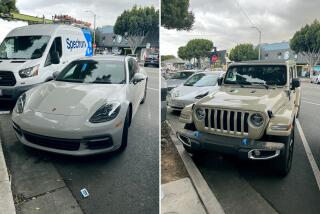THE GOODS : The Problem Is Clear
It began as just a little fleck, hardly visible. But Bob Pritchard of Riverside started noticing more and more of the patches all over his 1989 Ford Taurus.
No, it wasn’t urban pollution fallout. It was the car’s paint coming off, specifically the clear coat that is supposed to enhance the shine and protect the underlying color coat. Pretty soon, Pritchard began to notice plenty of other Tauruses with peeling clear coats just like his.
“I have taken over 40 photographs of other Tauruses,” he said. “I have to believe that Ford knows all about this problem.”
His problem, apparently shared by a number of other Ford owners, is sometimes known as clear coat delamination. Nobody is certain what causes it, but paint experts say that the Ford paint seems particularly vulnerable to sunlight and ultraviolet radiation. Ford has issued a technical service bulletin to dealers suggesting ways to more effectively repaint cars with damaged clear coats.
Nonetheless, Ford representatives say they are not aware of problems with the clear coat on Taurus models or any other paint problems that have affected the Taurus, the best-selling passenger car in America.
A nationwide controversy erupted in 1992, when the Center for Auto Safety petitioned the Federal Trade Commission and the attorneys general for every state seeking a mandatory recall by Ford to fix flaking paint on Ford F-100 pickup trucks.
The safety center, a public interest group associated with consumerist Ralph Nader, alleged that 400,000 Ford trucks had potentially defective paint and that Ford faced a $1-billion liability. Clarence Ditlow, safety center director, believes the same peeling problem is affecting Taurus, Sable and Windstar models.
Internal Ford documents obtained by the center appeared to show that Ford had deleted the use of a urethane bonding primer on the F-100 trucks, allowing the color coat to peel off. Ditlow asserts that the same paint process was used on the Taurus, though the clear coat peeling appears to be a separate problem.
The controversy died down in late 1993 when Ford struck a deal with the FTC that allowed the company to handle the problem through an “owners dialogue” program, in which it sent surveys to owners to determine whether they were having any problems. Ditlow calls the FTC settlement a “sellout” that left owners unaware that Ford was willing to provide free paint jobs in some cases.
Bill Carroll, a Ford spokesman, responds that the auto maker “did everything we were supposed to do. We paid to have these trucks repainted. All people had to do was bring them in.” Carroll added, “Ditlow is critical of everything, the entire auto industry. So what can we do about that?”
Since Ford settled with the FTC, at least two federal class action lawsuits have been filed against Ford for general paint problems, including clear coats. A number of Ford owners have also sued the company in small claims courts.
Pritchard said he eventually lost his bid to get help from Ford and has been forced to have his Taurus painted with new clear coat twice. “I expect to eventually have to repaint it again, if I keep it,” he said.
The safety center has prepared informational packages for Ford owners with paint problems. The packages can be obtained by sending a self-addressed stamped envelope to the Center for Auto Safety, 2001 S. St. N.W., Washington, D.C. 20009.
* Vartabedian cannot answer mail personally but will attempt to respond in this column to automotive questions of general interest. Do not telephone. Write to Your Wheels, 1875 I St. N.W. #1100, Washington, D.C. 20006.






